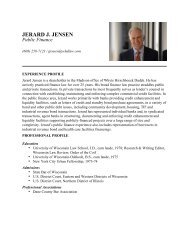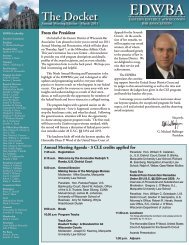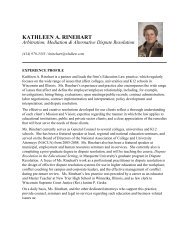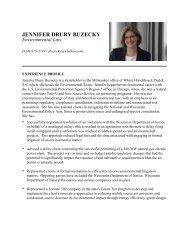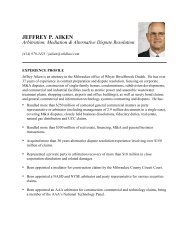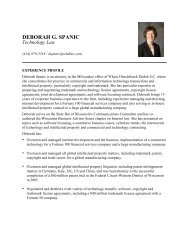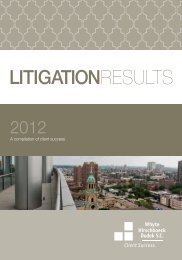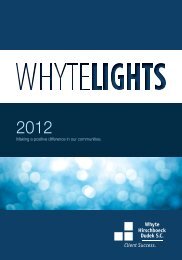FORETHOUGHT - Whyte Hirschboeck Dudek SC
FORETHOUGHT - Whyte Hirschboeck Dudek SC
FORETHOUGHT - Whyte Hirschboeck Dudek SC
You also want an ePaper? Increase the reach of your titles
YUMPU automatically turns print PDFs into web optimized ePapers that Google loves.
WRITTEN CONTRACTS ARE<br />
NOT ALWAYS SET IN STONE<br />
Written by<br />
Erin M. Keesecker<br />
Written contracts give businesses and<br />
individuals a sense of security and stability,<br />
in part because they seem difficult to<br />
break or modify. Most written contracts<br />
contain a section that dictates what<br />
the parties must do in order to change<br />
the agreed-upon contractual terms.<br />
This section often contains a “no-oralmodification”<br />
(NOM) clause, indicating that<br />
amendments must be “made in writing”<br />
and “executed by both parties.” Here is an<br />
example of such a clause:<br />
No amendments or modifications<br />
of this agreement shall be made<br />
or be deemed to have been made<br />
unless such amendments or<br />
modifications are made in writing<br />
and executed by the party to be<br />
bound thereby.<br />
In reading the NOM clause quoted above,<br />
most people envision the parties returning<br />
to the proverbial bargaining table,<br />
negotiating the amendment, and then<br />
signing an amended written document,<br />
perhaps under very similar conditions as<br />
existed when the original contract was<br />
formed. For purposes of formality, there<br />
may even be a notary present.<br />
That, however, is no longer the only<br />
scenario permitted by an NOM clause.<br />
Because the term “writing” does not<br />
necessarily mean putting pen to paper,<br />
NOM clauses may no longer be enough<br />
to bar contract amendments by informal<br />
email exchanges or even instant<br />
messaging (IM) conversations.<br />
The Enforceable Email Chain<br />
For instance, in 2009 the U.S. District<br />
Court for the Central District of California<br />
held that a series of informal emails<br />
between two parties to a written contract<br />
created an enforceable amendment,<br />
even though governing law, much like<br />
an NOM clause, required agreements<br />
to “be reduced to writing, or some<br />
memorandum, or notes thereof” and<br />
“signed by the party to be charged<br />
therewith, or some other person thereunto<br />
by the party lawfully authorized in<br />
writing.” The court ultimately employed a<br />
“substance over form” type of analysis,<br />
concluding that as long as a court can<br />
“plainly determine” the essential elements<br />
of the contract, i.e., “the identity of the<br />
parties to the contract, the nature of its<br />
subject matter and its essential terms,”<br />
an email chain is an adequate vehicle for<br />
amendment.<br />
The $1.2 Million Instant Message<br />
An even more dramatic example occurred<br />
in 2011 in the U.S. District Court for<br />
the Southern District of Florida. There,<br />
the parties’ NOM clause stated that the<br />
contract could be changed “only by<br />
a subsequent writing signed by both<br />
parties.” A dispute arose after the parties<br />
discussed modifying certain terms<br />
of the contract in a series of informal<br />
conversations via IM. The plaintiff argued<br />
that the IM conversation effectuated a<br />
contract amendment and demanded<br />
payment under the new terms; the<br />
defendant disagreed and refused to<br />
pay. More than $1.2 million in damages<br />
were in play. The court concluded that<br />
the IM conversation effectively amended<br />
the contract. Among other things, the<br />
court was influenced by the fact that<br />
the IM messages not only showed that<br />
the parties had come to an agreement,<br />
but also contained the specific terms<br />
of that agreement. Further, the court<br />
was influenced by the fact that the IM<br />
messages actually recorded the parties’<br />
efforts to carry out the agreed-upon<br />
amendments: “It is difficult to imagine<br />
more specific and direct evidence of an<br />
agreement than the two parties actually<br />
sitting down simultaneously and doing<br />
what they had agreed to do.”<br />
LITIGATION 31



